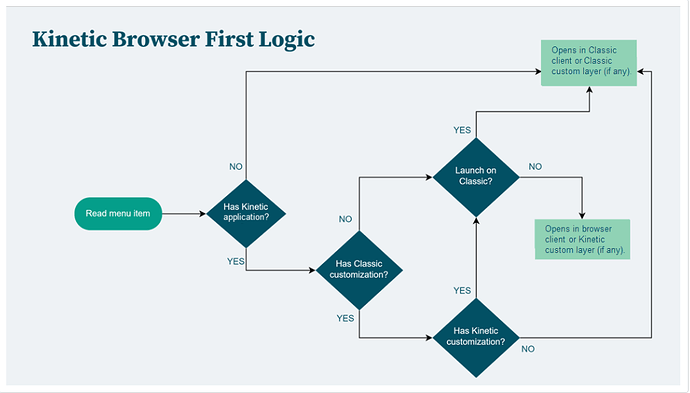Here’s the flowchart EpicCare gave me to “Explain it”:
Tim’s question to me when I said this exact same thing: “If you have a scenario where you have a custom field added in classic, but have not added it to Kinetic, wouldn’t you want the application to open the classic version in order for the user to be able to enter information into that field which would otherwise be unavailable in Kinetic?”
My answer was: It shouldn’t matter. Admins need ultimate control over what screen opens.
And here’s my suggestions for how it should work:
Q: When would I ever want to open base if I have a classic customization?
A: Maybe the only thing I did to the screen was move some fields around in classic. If that’s the case, and the upgrade to Kinetic is going to move them around anyways, it’s a pretty low priority for me to uplift that screen, but may still want the user to use it in the browser.
Q: How would you like it to behave?
A: Utilizing the ‘Form to Use’ field in the menu row to give admins complete control over what style screen opens. There will always be fringe cases where a flow chart just will not fit, and we need to retain control over those without cluttering up the menu with duplicate screens. There should be 4 options:
Auto - Use the flow you have defined as of today
Kinetic - Always open the new UX whether you’re in the browser or the smart client
Classic - Always open the classic UX whether you’re in the browser or the smart client. This can retain the “Browser First” functionality where it opens the classic screen when you’re in the browser
Environment – If you’re in the browser, open the new UX. If you’re in the smart client, open the classic UX. This would allow me to do role-based deployment of the new UX. For instance, let’s say that our Engineering Team has been voluntold to start using the new UX. Having the ‘Form to Use’ set to Environment would allow the rest of the organization to continue using the smart client and operate as usual with the classic screens while allowing the engineering team to use the browser and access the Kinetic screens whether or not there is a Kinetic layer applied to it.
Bonus: Developer Mode – Just like in classic today, there’s a developer mode toggle. I would love to see that in the new UX as well. When enabled, it would behave as follows: an admin would click on a menu item and a dialog box would pop up asking if the user would like to open Classic or Kinetic giving me the choice to be able to choose what I’m trying to alter.
